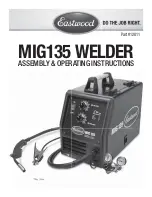
85
Chapter 6
W
elding Condition
S
ETTING
W
ELDING
C
ONDITIONS
W
ELDING
C
ONDITION
C
HAPTER
6
6.6.8
Penetration control adjustment
This section explains how to adjust the penetration control. Using the constant penetration function enables to
automatically adjust the wire feed speed so that the constant welding current can be assured even when the wire feeding
length changes.
Press the CONSTANT PENETRATION key. When the LED of the key is ON, it means the penetration control is ON.
This results in reduction of changes in penetration depth and bead width of the base material. Especially for welding
where you desire to make penetration depth constant, use the welding power source with this penetration control function
enabled.
T I P S
• The penetration control is available when "DC" is selected by the "WELDING METHOD" menu.
• The penetration control function is available when "MILD STEEL SOLID", "MILD STEEL CORED",
"STAINLESS STEEL SOLID" or "STAINLESS STEEL CORED" is selected by the WIRE MATERIALS menu.
• The penetration control functions only during the production weld while it does not during the initial
and crater processes. Also, the function cannot be used in arc spot.
6.6.9
Adjustment of wave frequency
This section explains how to adjust the wave frequency. In wave pulse welding, cyclically accumulating two separate unit
pulse conditions at low frequency enables to obtain continuous weld bead looking like rows of fish scales.
Aluminum welding makes a ripple bead using an overlap method.
It can also make welding easier, even if there is a gap between weld parts, because it performs a crystal miniaturization
by vibrating the molten pool, and the welded part becomes more resistant to cracking.
The wave pulse welding changes the wire feeding speed and unit pulse condition.
When it close to the limiting value of response characteristics of wire feed motor, it makes the feeding amplitude small
automatically.
When the wave frequency is 3 Hz or more, the amplitude of feeding speed becomes small. At 5 Hz or more, it disappears.
In this case, the wire feeding speed becomes stable and only the unit pulse condition changes.
<Image of welding bead form in the wave frequency>
T I P S
• This function is available when "DC WAVE PULSE" is selected by the WELDING METHOD menu.
• Wave pattern of the welding bead may not appear clearly depending on the temperature (heat input)
during welding.
• When using hard aluminum or soft aluminum, bead surface may blacken somewhat if short-circuit
occurs frequently during the welding operation.
• Even if the welding power source is used in Standard mode, a good weld can be obtained by setting
the wave frequency at 5 Hz or more.
• When welding steel or stainless steel materials in wave pulse welding, it takes time for the molten
metals to coagulate. Since the molten metals will flow during that time, it may not be possible to make
clear weld beads looking like rows of fish scales. Still, the blowholes can be reduced due to the mixing
effect caused by vibration of the molten pool.
Wave frequency
Image of welding bead form
Low
High
















































